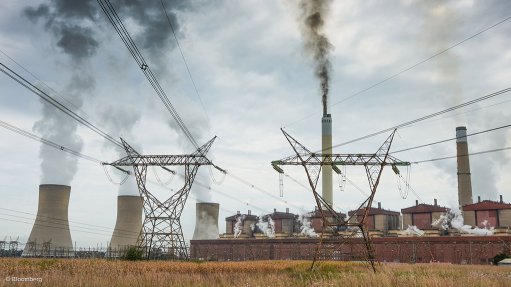Economist warns of consequences of low growth, potential tax hikes
It is well known that the South African economy is having serious growth challenges, which is unlikely to improve over the next three years, with best estimates that the country’s gross domestic product (GDP) will grow by just 2% during this period.
This is according to financial services company Citibank South Africa chief economist Gina Schoeman, who on Wednesday addressed a media roundtable ahead of Finance Minister Malusi Gigaba’s inaugural Medium-Term Budget Policy Statement on October 25.
Schoeman warned that the downside risks for lower-than-expected GDP growth were “fierce”. She explained that rating agencies placed a major focus on a country’s real per capita GDP and that South Africa has been forecast to record a -0.6% average per capita growth rate between 2009 and 2018.
This meant that there had been an incremental deduction in the wealth of all South Africans during this period. “Even though the average person on the street might not understand the technicalities of these calculations, I can assure you that they will feel it in their day-to-day living standards.”
Further, she said the “real issue” to focus on was the country’s nominal GDP, which Schoeman described as “ludicrously” lower than it had been throughout the past 20 years.
She said this was somewhat curious as inflation was running at about 6% year-to-date. Schoeman explained that this was problematic, as, until the beginning of 2017, South Africa had mostly experienced an increase in inflation rates that coincided with nominal GDP growth. However, over the past five years, inflation had been creeping up, while nominal GDP growth continued to slow.
She elaborated that this was owing to the fact that the South African economy was weakening at such a rapid rate, that nominal GDP was slowing down and as a measure of the size of the economy, it was indicative of why contributions from sectors of the economy, such as mining and manufacturing, had decreased significantly during this period.
Schoeman stressed that this slowdown would certainly have an impact on fiscal policy decisions including possible increases in taxation for the top 10% of income earners, who already contribute 72% of the South African personal income tax base.
She noted that the top 10% would simultaneously also face significant additional costs in private healthcare and education, besides others.
“I think higher-income earners had expected to have to deal with higher taxes and contribute accordingly. However, if they are pushed too much, [we will] have [a] Laffer Curve situation occurring,” Schoeman cautioned.
She explained that Laffer Curve is a theory developed by economist Arthur Laffer to show the relationship between ideal tax rates for government to generate the maximum amount of tax revenue. However, if the tax rate gets too high, the tax revenue will drop off.
“The limits of taxation on the higher-income earners are currently being severely tested in South Africa,” said Schoeman, adding that, earlier this year, during the Tax Indaba, the South African Revenue Service reported that tax compliancy rates were the lowest they had been in the past five years.
In response to a question from Engineering News Online regarding how close South Africa was to reaching a Laffer Curve scenario, she noted that tax revenue had accounted for about 25% of GDP over the past 20 years in South Africa; however, tax revenue was starting to decline and was affecting tax buoyancy rates, which suggested that the threshold was close to being met.
“Maybe there is room to push taxation rates a little bit further, but there certainly is not a huge amount of room. However, I believe, to fix the fiscal policy mess that we are in currently, tax hikes, particularly income tax, should not be the only solution and more fiscal prudency will be needed,” Schoeman stated.
Article Enquiry
Email Article
Save Article
Feedback
To advertise email advertising@creamermedia.co.za or click here
Comments
Announcements
What's On
Subscribe to improve your user experience...
Option 1 (equivalent of R125 a month):
Receive a weekly copy of Creamer Media's Engineering News & Mining Weekly magazine
(print copy for those in South Africa and e-magazine for those outside of South Africa)
Receive daily email newsletters
Access to full search results
Access archive of magazine back copies
Access to Projects in Progress
Access to ONE Research Report of your choice in PDF format
Option 2 (equivalent of R375 a month):
All benefits from Option 1
PLUS
Access to Creamer Media's Research Channel Africa for ALL Research Reports, in PDF format, on various industrial and mining sectors
including Electricity; Water; Energy Transition; Hydrogen; Roads, Rail and Ports; Coal; Gold; Platinum; Battery Metals; etc.
Already a subscriber?
Forgotten your password?
Receive weekly copy of Creamer Media's Engineering News & Mining Weekly magazine (print copy for those in South Africa and e-magazine for those outside of South Africa)
➕
Recieve daily email newsletters
➕
Access to full search results
➕
Access archive of magazine back copies
➕
Access to Projects in Progress
➕
Access to ONE Research Report of your choice in PDF format
RESEARCH CHANNEL AFRICA
R4500 (equivalent of R375 a month)
SUBSCRIBEAll benefits from Option 1
➕
Access to Creamer Media's Research Channel Africa for ALL Research Reports on various industrial and mining sectors, in PDF format, including on:
Electricity
➕
Water
➕
Energy Transition
➕
Hydrogen
➕
Roads, Rail and Ports
➕
Coal
➕
Gold
➕
Platinum
➕
Battery Metals
➕
etc.
Receive all benefits from Option 1 or Option 2 delivered to numerous people at your company
➕
Multiple User names and Passwords for simultaneous log-ins
➕
Intranet integration access to all in your organisation



















